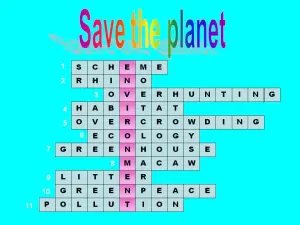Тема урока: "Save the Planet". 8-й класс

Скачать презентацию (3.47 МБ)
Тип урока: обобщающий.
Цель урока: закрепление знаний учащихся по теме.
Задачи урока:
- Развивающие: способствовать развитию логического мышления, творческого воображения, умения выражать свое мнение.
- Учебные: активизировать лексику по теме в разных видах деятельности: чтении, аудировании, говорении, письме.
- Воспитательные: подвести учащихся к необходимости внесения своего вклада в защиту природы.
Оснащение урока:
- Компьютеры;
- Видеокассета к учебнику «Click on 2» с песней «Save the Planet»;
- Аудиокассета к учебнику «Click on 4»;
- Телевизор, видео, аудиомагнитофоны;
- Диск со слайдами;
- Небольшие красочные изображения бабочек, птичек, редких животных из «Красной книги», цветов и т.д.;
- Эмблемы каждой группы;
- Яблоко
ХОД УРОКА
T.: Good morning children!
Good morning dear guests!
Today we have our conclusion lesson on the topic «Save the Planet»
We’ll continue speaking about ecology.
We’ll go deeper into the problems and their influence on the man and wildlife.
– What problems are we talking about?
– Please, look at the screen, do the crossword and try to guess the name of the problem.
Crossword (slide 0).
- The synonym for the word program, project (scheme).
- Rare animal species (rhino).
- This causes the extinction of rare animal species (overhunting).
- The natural home of a plant or animal (habibat).
- Too many people in one place (overcrowding).
- School subject studying natural relations of plants, animals, people to each other (ecology).
- An increase of its effect may lead to global warming (green house).
- A beautiful parrot which is in danger of extinction (macaw).
- The synonym for the word rubbish, waste (litter).
- The organization which fights against pollution of nature (greenpeace).
- Making water, air, land impure and dangerous for people and animals to live in (pollution).
T.: What word have we got?
Cl.: Environment.
T.: So, what problems we are going to speak?
Cl.: We are going to speak about Environmental problems.
T.: The theme of our lesson is «Save the Planet» (slide 1).
– I suggest you to begin with the words of the song. Listen and repeat line by line altogether. (slide 2).
– Can you think of an alternative to the theme of our lesson? (slide 3).
T.: Thank you, children.
We live on the planet Earth.
Nowadays it is in great danger, because it has been suffering from many environmental
problems.
Have a look at these pictures.
– What problems do these pictures relate to? (slide 4).
P1. This picture relates to the problem of air pollution because factories and plants dump industrial waste on the air.
P2. This picture relates to the problem of water pollution because the beach is covered with litter.
P3. This picture relates to the problem of deforestation because the man is planting trees.
P4. This picture relates to the problem of endangered species because tigers are endangered species.
T.: Thank you. What other environmental problems do we face today?
P1 – global warming.
P2 – the green house effect.
P3 – overfishing, overhunting.
P4 – ozone holes.
T.: So, we have a lot of environmental problems.
What should we do to protect our environment?
Let’s work in pairs.
Take yours seats at the computers.
Fill in the following chart. Disk «Test your Grammar» by Pavlotskey.
You’ll have to choose environmental problems and write them in the first column.
In the second column you’ll have to write the ways of protecting our planet.
– What marks have you got?
– Thank you, well done, you are so clever, I’m proud of you.
T.: Another task for you is listening. Before listening to the text look at these phrases and repeat after me (slide 5).
– Do you understand these words?
T––>C1. What is the Russian (English) for…?
T.: Now listen to the text (slide 5a)
T.: Shall we listen to this text again?
Cl: No, we shan’t.
T.: Let’s start to do the task using the computers. (Fill in the gaps with the following words).
– Well done. What marks have you got? Good job.
T.: Now children let’s have a rest and remember the poems we learned before.
T.: Let’s continue our lesson. Let’s watch how people discuss the problems. (We are also interested)
– Now find the files «Dialogues» (Приложение 1) and try to make similar dialogues arange the phrases in the logicalorder.
– What have you got with your dialogues?
T.: We’ve discussed a lot of problems, done a lot ofexercises.
And now I think our groups are ready to tell us about different problems.
We have four ecological groups in our class. They are:
- Clean Air (Приложение 2)
- Friends of the water (Приложение 3)
- Animal lovers (Приложение 4)
- Forest’s tears (Приложение 5)
– Let’s listen to the first group «Clear air» and watch the presentation they have made.
T.: Thank you. Let’s listen to the second group.
T.: Nice work, children.
Our lesson is compiling to an end.
Look at the apple.
Imagine it’s our Earth.
I’m cutting it into 4 pieces:
– Our lesson is coming to an end.
Look at the apple. Imagine it’s our Earth. I’m cutting it into 4 pieces: Three
quarters of the Earth surface is water and only 1/4 is land. One half of it is habitable.
The rest of the land is desert, mountains, frozen ice-caps and other places where people
cannot live in. And now I’m cutting this half into four parts. It’s impossible to
believe but only 1/32 gives us food and shelter. And it will be a catastrophe if we
destroy it.
– I’d like you to think over this problem much more serious and find out ways to save our fragile planet.
A song «Save the planet».







